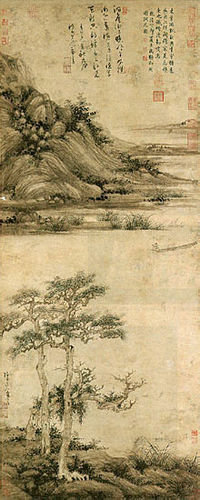Dongting Lake
| Dongting Lake | |
|---|---|
| Location | Hunan province |
| Coordinates | 29°18′38″N 112°57′05″E / 29.31056°N 112.95139°E |
| Primary inflows | Yangtze, Xiang, Zi, Yuan, Li |
| Primary outflows | Yangtze |
| Basin countries | China |
| Surface area | 2,820 km² (flood season: 20,000 km²) |

Dongting Lake, or Lake Dongting (Chinese: 洞庭湖; pinyin: Dòngtíng Hú; Wade–Giles: Tung-t'ing Hu) is a large, shallow lake in northeastern Hunan province, China. It is a flood basin of the Yangtze River (Chang Jiang). Hence the lake's size depends on the season. The provinces of Hubei and Hunan are named after their location relative to the lake: Hubei means "North of the Lake" and Hunan means "South of the Lake" in Chinese.
Dongting Lake is famous in Chinese culture as the place of origin of Dragon boat racing. It is the site of Junshan island, and is a home to the Finless Porpoise, which is endangered in China.
Geography
In the July–September period, flood water from the Yangtze flows into the lake, enlarging it greatly. The lake's area, which normally is 2,820 km² (data before 1998), may increase to 20,000 km² in flood season, when vast amounts of water and sediment from the Chang Jiang flow into the lake. The lake is also fed by four major rivers: the Xiang (湘), Zi (资), Yuan (沅) and Li (澧) rivers. Small rivers also flow in, the most famous one being Miluo River where a famous poet Qu Yuan committed suicide. In addition, the Xiao River(瀟) flows into the Xiang near Yongzhou, before the Xiang flows into the lake. Ocean-going vessels can travel through the Xiang to reach Changsha.
History
During the Han Dynasty, Yunmeng Marsh (Chinese: 雲夢大澤; pinyin: Yúnmèng dàzé), which lies to the north of Dongting Lake in Hubei Province, served as the main flood-basin of the Yangtze. The rich sediment of the marsh attracted farmers. Embankments were built, keeping the river out, and the Dongting Lake area south of the Yangtze gradually became the river's main flood-basin.
At that time, Dongting Lake was China's largest lake. Because of its size, it gained the name Eight-hundred-li-Dongting (八百里洞庭). Nowadays, it is the second-largest, after Poyang Lake (鄱陽湖), as much of the lake has been turned into farmland.
Culture and mythology

The area is well known in Chinese history and literature. Dragon boat racing is said to have begun on the eastern shores of Dongting Lake as a search for the body of Qu Yuan (屈原), the Chu poet (340-278 BC), and a dragon-king is said to live at the bottom of the lake.
Junshan (君山), which was formerly a Daoist retreat, is a famous one-kilometer island with 72 peaks in the middle of the lake. The island is also famous for its Junshan Yinzhen tea. The basin of Dongting Lake and its surrounding area is famous for its scenic beauty, which has been encapsulated in the phrase 瀟湘湖南 (Xiao1-Xiang1 Hu2nan2; "Hunan of the Xiao and Xiang rivers").
The scenery of the Jiuyi Mountains (九嶷山) and of the Xiao and Xiang rivers below is often mentioned in Chinese poetry. During the Song Dynasty, it became the fashion to paint this region's scenery in a set of eight scenes, usually entitled as Eight Views of the Xiao and Xiang (瀟湘八景). The fashion spread to Japan, where eventually other famous places were substituted for the Xiao and Xiang rivers.
Environmental issues
In 2007 fears were expressed that China's Finless Porpoise, a native of the lake, might follow the baiji, the Yangtze river dolphin, into extinction.
There have been calls for action to save the finless porpoise, of which there are about 1400 left living, with approximately 700 to 900 in the Yangtze, and approximately another 500 in Poyang and Dongting Lakes.
The 2007 population levels were less than half the 1997 levels, and the population continues to drop at a rate of 7.3 per cent per year.
Pressure on the finless porpoise population on Poyang Lake comes from the high numbers of ships passing through, as well as sand dredging.[1]
After flooding of the Yangtze River in late June 2007, approximately 2 billion mice were displaced from the islands of the lake. The mice invaded surrounding communities, damaging crops and dikes and forcing the government to construct walls and ditches to control the population.[2]
The lake was also featured on news services as having a problem with schistosoma and malaria infected mosquitoes.
Billions of mice were forced from their holes and were sent scurrying into local villages when officials opened the sluice gates on Dongting Lake in June 2007 to relieve flooding. Villagers killed an estimated 2 billion mice by beating them with shovels or using poison. The rotting mouse corpses should have been properly disposed of, and other animals - such as cats and dogs - were the unintended victims of the poisons.
A restoration project, the Sino-Norwegian Project of Biodiversity Protection Management (a joint Norwegian-Chinese endeavor), began in 2005. According to a 2007 article in the China Daily, "[The Dongting Lake area] will be restored to a sustainable biodiversity environment within five to 10 years".[3]
Major cities on the Lake
See also
- Hunan
- Yangzi River
- Junshan Island
- Xiaoxiang
- Eight Views of Xiaoxiang
- Xiang River
- Emperor Shun
- Spotted bamboo
- Xiang River goddesses
References
- ^ http://www.chinadialogue.net/article/show/single/en/839-Poyang-Lake-saving-the-finless-porpoise www.chinadialogue.net - Poyang Lake saving the finless porpoise
- ^ http://www.physorg.com/news103199287.html www.physorg.com - 2 Billion Chinese Mice Overrun Lake Area
- ^ "Lake back to health in 5 to 10 years" (on the website of the Ministry of Water Resources of the People's Republic of China.)
